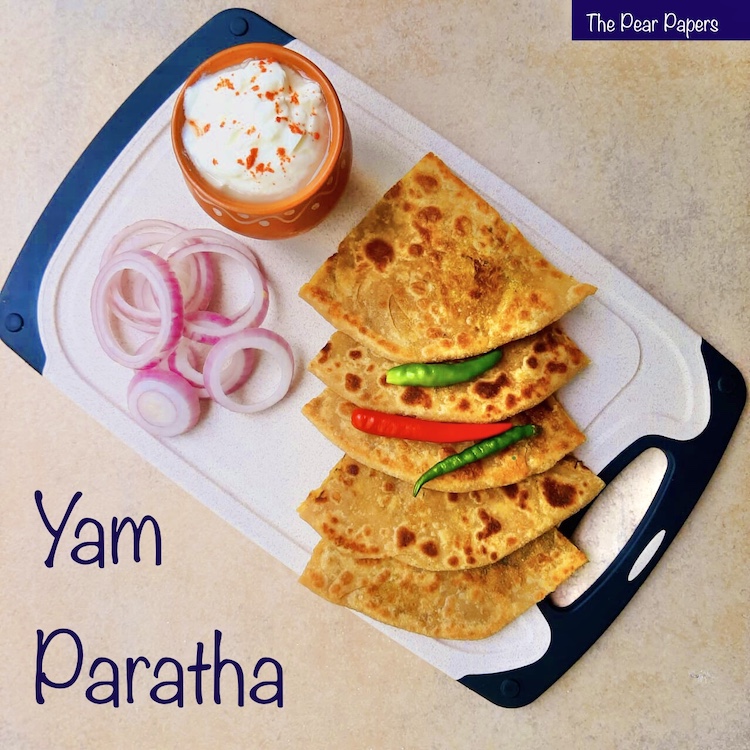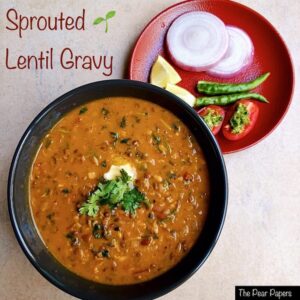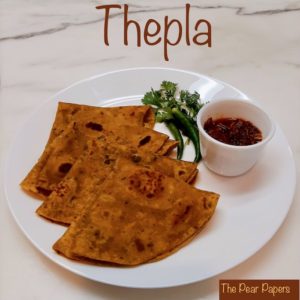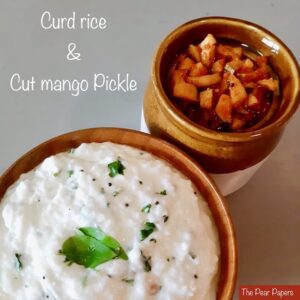
Yam Paratha
Paratha is a stuffed Indian bread, made with whole wheat flour and vegetables. It is very famous in North India and a staple in many families. Most common stuffings used to make parathas are potato, paneer (cottage cheese), mix veg, sweet potato, cauliflower etc. There are several combinations of spices and other ingredients and you can experiment with literally anything in your pantry to create new stuffing varieties. Yam Paratha is one such spicy and tasty paratha.
Yam is a very simple, tuber vegetable, often neglected because it is messy to clean and de-skin. But it is highly nutritious and can be substituted in many recipes that use potato. Once de-skinned, it is easy to cut and use. Steam cooked, grated yam is sauteed with onions and spice powders and stuffed inside whole wheat dough. It is then rolled out, cooked on a flat pan/tawa till golden and enjoyed with a simple yoghurt based dip or Indian dal.
Here’s my recipe for Yam Paratha. It’s a fairly heavy meal so it’s better eaten earlier in the day. I’ve included several tips for making stuffed parathas that I learnt from my close friend who is an expert in it.
Ingredients
Whole wheat flour – 2 1/2 cups + 2 tbsp for dusting
Salt – 1 tsp (or to taste)
Sugar – 1/2 tsp
Unsalted butter – 1 tsp
Yam (steam cooked and grated) – 2 cups packed (see note 2)
Cumin seeds – 1/2 tsp
Onion (finely chopped) – 1 medium sized
Green chillies (finely chopped) – 1 tbsp (or to taste)
Ginger (finely chopped) – 1 tsp
Turmeric powder – 1/2 tsp
Fennel powder – 1/2 tsp (see note 5)
Dry mango powder/lime juice – 1/2 tsp
Red chilly powder – 1/2 tsp (or to taste)
Fresh coriander leaves (finely chopped) – 2 tbsp
Cooking oil – 1 1/2 tbsp
Ghee – 3 tbsp (or as required)
Water – As required
Yield
7 or 8 parathas
Prep time
1 hour
Cook time
20 mins
Method
1) In a wide bowl, take 2 1/2 cups wheat flour, 1/4 tsp salt and 1/2 tsp sugar. Mix thoroughly. Add water little by little and knead the flour to form a soft pliable dough. Now add the butter to the dough and knead for 5 more mins until it is fully incorporated. By now the dough will be non-sticky and very soft to touch. Cover it with a clean kitchen cloth and let the dough rest for 45 mins.
2) While the dough is resting, clean the yam, peel the outer skin, wash it again and cut into chunks.
3) In a pressure cooker/steamer, (if you don’t have both, then check broken wheat pidi kozhukkattai recipe for a DIY makeshift steamer) steam cook the yam chunks until 90% cooked. (see note 4)
4) Remove the yam chunks from the steamer and let it cool down a bit. Now grate it and set aside.
5) In a pan/kadai, add cooking oil and heat it. Add cumin seeds and let it splutter. Now add chopped green chillies and ginger. Fry for a minute on medium heat.
6) Now add the onions and 1/4 tsp of salt and fry until it turns translucent.
7) Then reduce the heat to minimum and add turmeric powder, chilly powder, fennel powder and dry mango powder/lemon juice and mix once quickly.
8) Immediately add the grated yam, 1/2 tsp of salt and chopped coriander leaves. Mix well and cover the pan. Keep the heat in minimum and allow the yam to absorb the flavours from the spice powders and also the salt to be incorporated. Keep the pan covered for 5 to 6 mins and let the yam cook fully. Whatever extra moisture is there will also evaporate during this process.
9) Now remove the yam stuffing from heat and allow it to come to room temperature. Then make lime sized balls from this and set aside.
10) Take the dough that is resting and make big lemon sized balls. Take one dough ball, use some wheat flour for dusting and start rolling it out. Roll to roughly about 10 cm wide circle, with the center slightly thicker than the edge.
11) Take the yam stuffing and place it in the center of the rolled out dough. Gather the edge of the dough and seal the yam mixture in fully – kind of like a dumpling. Now dust this yam-filled paratha dough ball with wheat flour and roll it out gently (use wheat flour for dusting as required). Now heat a flat pan/tawa until it is medium hot.
12) When the pan is medium hot, place the rolled out paratha on it, drizzle some ghee around the yam paratha and cook the first side. Cook until you see small bubbles on top of the paratha. Now flip the paratha using a flat spatula. Again drizzle some ghee around the edges and on the surface of the paratha and allow this side also to cook for nearly 30 secs. Again flip the paratha, smear some ghee over the surface and around the edges. Press the paratha gently on all sides with the spatula. You will see small golden colour dots/patches appear on both sides of the paratha, indicating that the paratha is done. Remove yam paratha from the pan and place it in a hot pack lined with a clean kitchen cloth (if you are not serving immediately). Cover the paratha with a cotton cloth.
13) Cook all the parathas the same way. Serve this yam paratha with plain yoghurt/pickle (try our fenugreek grape pickle)/fruit preserve (see our Mango Plum preserve)/dhal tadka/fresh cut raw onions or just fried green chillies. Just plain yam paratha without any accompaniment also tastes great. When paired with any yoghurt based dip or Indian dhal it becomes a wholesome meal.
Notes
- I suggest to steam cook yam and not boil it in water. This is because the yam retains extra moisture while boiling which is difficult to remove, and will make it difficult to stuff it inside the dough. While rolling out the parathas, the dough may tear open and the stuffing may squish out and make it very messy to handle. So steam cook, grate and saute the yam to get the right consistency of stuffing. If by chance your stuffing is too moist, then you will need some binding agent to hold it together, so that it stays intact inside the dough and doesn’t squish out while rolling. You can add some almond flour/roasted peanut powder/rolled oats powder/roasted gram powder to the yam onion mixture and bring it to right consistency (you should be able to make smooth balls out of this mixture without making your hands messy).
- I’ve used store bought fennel powder for this recipe. If you don’t have ready made fennel powder, then making one at home is very easy. Just dry roast 1/4 cup of fennel seeds in a pan/kadai on low heat for 4 to 5 mins, or until it becomes warm to touch. Switch off the heat and leave the pan with roasted fennel seeds on the hot stove top until it comes to room temperature. Keep stirring every 2 mins while it cools down. Now grind this into a fine powder, store it in a dry, airtight container. Use this fennel powder to add flavour to your dishes. It helps in better digestion too!
Beginner’s Tips
- Add water little by little and bring the dough to a soft, pliable consistency. If the dough becomes loose and sticky, you will need more wheat flour on the rolling surface. This will also make the paratha hard. So don’t add all the water right at the beginning while making the dough. The amount of water needed to make the dough varies with the brand of wheat flour you use.
- It’s better to rest the dough for a minimum of 30 mins. This resting time will help you roll out the dough easily and make soft parathas.
- Adding ghee gives great flavour to the parathas. A mix of ghee and oil/butter can be used to make this paratha. Use at least half a tsp of ghee or butter for each paratha so they stay soft for a long time.
- If you’ve never prepped yam before, here are a few tips to help you out:
– Never let the yam sit out after you buy it. If you let it sit in summer, it will dry out, starting from the skin, all the way down to the flesh. If you let it sit in winter, it’ll catch fungus from the bottom and the flesh will start to rot. Either way, it is better to prep your yam as soon as you buy it.
– De-skin the yam first using a large sharp knife and then cut it up into chunks.
– Wash the chunks and leave them out to air-dry on a cloth.
– After a couple of hours when the chunks have dried, put them in an airtight container that is lined with a clean kitchen towel and refrigerate.


You May Also Like

Sprouted Lentil Gravy
May 21, 2023
Thepla
January 31, 2021